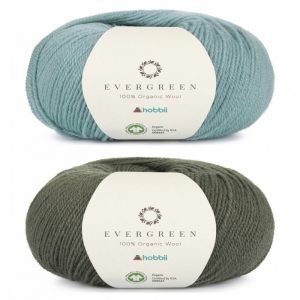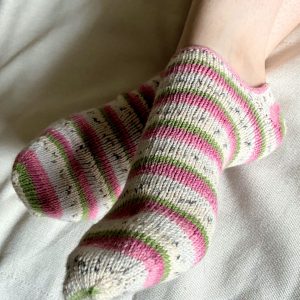Here are the 8 most popular ways to seam knitted fabric together with some tips on how to select the most suitable method for each project.
1. Kitchener Stitch
Kitchener stitch (also known as grafting) is a technique that you can use to create an invisible horizontal seam by joining two rows of live stitches together. Basically, you just knit a row between two rows with a tapestry needle.
Kitchener stitch is good for:
- Closing the toe of a sock, top of a mitten, or hat.
- Joining the two ends of an infinity scarf or headband together.
- If you want to remake for instance yoke of your top-down sweater again without having to undo the whole work. First, you can cut your knitting into two pieces and remake the yoke and then join it to the lower body again.
2. Finchley Graft
Finchley graft produces a similar result as the Kitchener stitch and it works for the same use cases but you work it from the wrong side of the work. This technique is probably a little bit easier to learn than the Kitchener stitch.
3. Mattress Stitch
Mattress stitch is a technique that you can use to create an invisible vertical seam.
This method is good for joining for instance the front and back pieces of a sweater or making the sleeve seams.
4. 3-Needle Bind-Off
This technique and the Kitchener Stitch, as well as Finchley graft, are somewhat interchangeable but since the 3-needle bind-off produces an actual seam it offers some structural integrity. Thus it’s a better option for finishing the shoulder seams of a bottom-up sweater for instance but not so good option if you want to do some sweater surgery.
What I like about this method is that you don’t have to go and find a tapestry needle because you can create the seam by knitting.
5. Pick Up and Knit
This method is commonly used when knitting sweaters top-down. One can pick-up and knit stitches on shoulder seams and underarm. Also button and neck bands are often attached to the rest of the work this way. It’s commonly used also on modular designs such as shawls.
With this method you get neat and strong seam and you don’t need a tapestry needle.
6. Back Stitch
Back stitch is a method that creates a strong, sturdy seam. This is a fairly easy method to learn and good if you want to make your garment a little bit more fitted since it requires some seam allowance.
7. Whip Stitch
Whip stitch is probably the easiest seaming method to learn but that said it’s not as invisible as Mattress stitch or Kitchener stitch.
8. Slip Stitch Crochet
If you know how to crochet you can use a hook to quicky create a strong and neat seam. This method works for both horizontal and vertical seams. This is also very easy seam to undo.
The end result is very similar to the one produced by the Mattress stitch.











4 Responses
Thank you for the wonderfully clear instructions
for making the Kitchener stitch. I enjoyed
your video so much. I am looking forward
to trying the K stitch.
Thank you Ida for sharing this information in one spot lol. Usually I am trying to figure out what seaming method to use and I start down that ‘rabbit’ hole and come up for a breathe sometime later without figuring out which seaming method to use! I appreciate your assistance.
Hello Ida,
You are doing a great job in keeping your readers fully informed with really useful advice.
I like to make blankets, mostly for charity and mostly using reversible patterns, and was wondering if you know of a method which allows squares to be joined to each other so that each side of the fabric looks the same. If you use mattress stitch, for example, one side becomes the front (with a neater appearance) and the other side becomes the back. That’s fine for garments, of course, but what would you recommend for a project which might be presented/used on either side?
Best wishes,
Jenny Reid
hi, ida – i just received my fifth sock knitting tip email, and spent a while looking over more of your site. wow, there’s so much information here! it’s just really impressive. thank you so much for all your hard work, which is going to help me improve my sock, hat, and glove knitting.